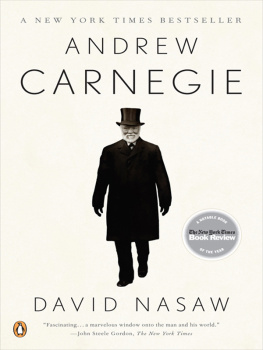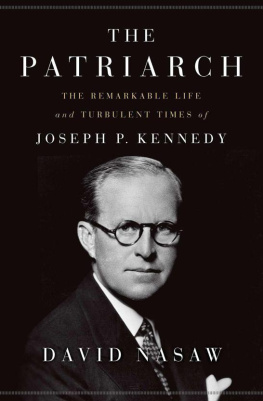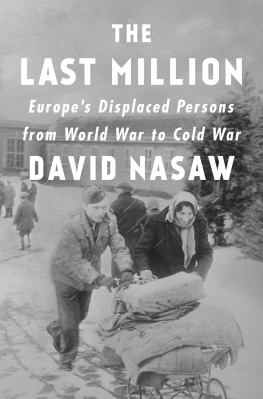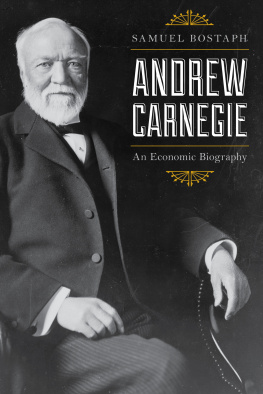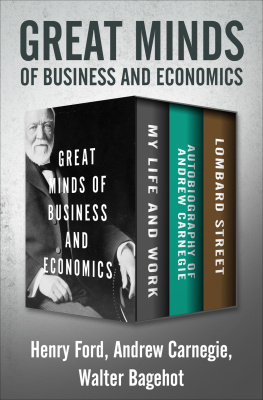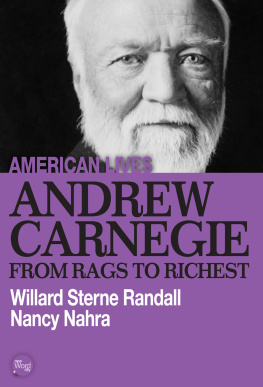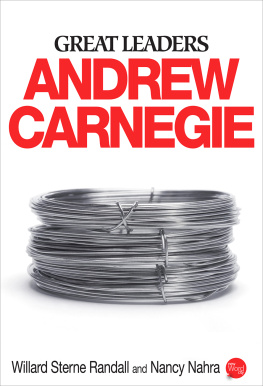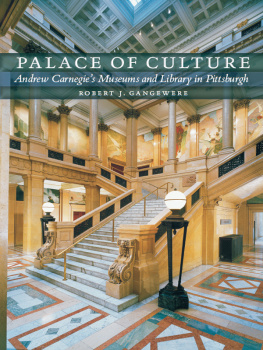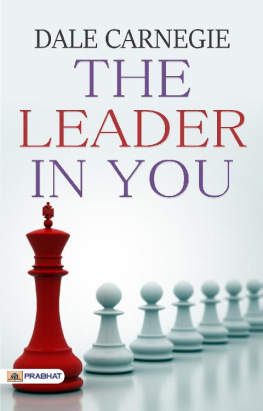*I have not included redundant information in the notes when the source of a citation is found in the text.
*Though the names were similar, the Union Pacific, Eastern Division, was not connected to the Union Pacific.
* Cacoethes scribendi, translated best into an itch or mania for writing, has been attributed, among others, to Juvenal, Addison, and Oliver Wendell Holmes, Sr.
*Louise Whitfield kept a diary all her life, which forms the basiswith interviewsof the biography written by Burton Hendrick and his collaborator, Daniel Henderson. Because I was unable to locate any of Louises personal papers, I have had to rely on the Hendrick and Henderson biography for most of what follows. It is entitled Louise Whitfield Carnegie: The Life of Mrs. Andrew Carnegie, and was published by Hastings House in 1950.
*There are two versions of Carnegies account of this trip. The first, privately printed in 1882, was entitled Our Coaching Trip; the second, published by Charles Scribners Sons in 1883, was entitled An American Four-in-Hand in Britain.
*The magnificent Carnegie library and social center at Braddock, with swimming pool, public baths, bowling alleys, art gallery, gymnasium, and billiard hall, was constructed in 1889.
*The name was borrowed from the collapsible cane that artists used as a walking stick when strolling the citys streets and to prop up their hands while painting.
*Colin Hunter was a well-known painter; the R.A. stands for Royal Academy.
*The original document, on which duplicate is clearly written, was sequestered in a safe at the Home Trust Company in Hoboken, New Jersey, a private bank Carnegie established in 1901 to administer his trust funds and serve as the executor of his will. Only when the building in which the papers were stored was demolished in 1998 was this document, along with Carnegies 1888 correspondence with his lawyers, discovered by the contractor and, with the assistance of Kenneth Miller and Vartan Gregorian, purchased by Columbia University. All documents regarding William Carnegies naturalization are in series IX, box 8, folder 10, CCNY; for a copy of the Declaration of Intent, without the duplicate notation, see vol. 1, ACLC.
*The Carnegie firms in Pittsburgh were organized into two separate companies, each owned by the same group of partners. Carnegie, Phipps owned Homestead; Carnegie Brothers, Edgar Thomson. Abbott was the chairman of the board of Carnegie, Phipps; Frick of Carnegie Brothers.
*We dont know why he referred to his rivals as blackmailers. In the heat of battle, he was likely to say such things about competitors.
*Carnegies birthplace in Dunfermline has been preserved, but his first home in America was torn down in the 1960s to make room for Three Rivers Stadium.
*Furnaces, once cooled, were subject to damage and took a considerable amount of time to start up again.
*These figures include only steel made in Bessemer ovens, not that made in the open-hearth ovens like those Carnegie had installed at Homestead.
*The Homestead events of 1892 can be described as both a lockout and a strike. The lockout came first, when the plant was shut down. But it was transformed into a strike when Frick invited the workers back to the planton his termsand they refused to do so.
*We dont know precisely what Carnegie was referring to here. It might have been the landing of the Pinkertons or the decision to bring in scab labor.
*For the new few years, the annual exhibition would veer back and forth between being a showcase for American artists and an exhibition of the years best paintings regardless of nationality. Despite Carnegies wishes, the directors and judges would, in rather short order, open the exhibit to non-American artists. Over the next century and more, the Carnegie International would present the best in contemporary paintings, sculpture, and, more recently, video and photographic artists, to Pittsburgh audiences.
*Carnegie would, for the rest of his life, insist on misspelling Rockefellers name in various ways.
*Carnegie must have been referring to John Stuart Mill here, though I can find no reference to the statement cited.
*Kenneth Warren, whose account of the breakup is the most compelling we have, concedes that from this point on it is difficult to follow the sequence of events. There was clearly further tampering with the company records. The evidence now available is not complete Triumphant Capitalism, 255.
*Years later, according to a story that Schwab told Hendrick, Carnegie and Morgan met on board an ocean liner crossing the Atlantic. Carnegie told Morgan that he realized now he should have asked for an additional $100,000. Well, replied Morgan with a grin, you would have got it if you had. Carnegie denied the story, and claimed that he had named a price he thought eminently fair. I have been told many times since by insiders that I should have asked $100 million more and I could have gotten it easily, he told congressional investigators in 1912. Once and for all I want to put a stop to all this talk.Hendrick, II, 142; Hendrick interview with Schwab, vol. 257, ACLC; U.S. Steel, 2379.
*Sixty-seven of them would be built, with Queens getting a few extra. When, in 1996, Mary Dierick wrote her book about the New York City Carnegie libraries, she found that fifty-seven of the buildings were still standing, fifty-four of them operating as branch libraries.
*There is a listing for a Carnegie, William, weaver, Rebecca Street in Woodward & Rowlands Allegheny Directory for the Year 1852.
*The Carnegie Institution began life with a $10 million endowment, to which Carnegie added an additional $2 million in 1909 and $10 million in 1911. Rockefellers Institute for Medical Research, the precursor to Rockefeller University, was launched with a grant of $200,000; in 1903, Rockefeller donated an additional $660,000 for a tract of land on which to build a permanent home for the institute on York Avenue; in 1907, he responded to a request from his directors for a $6 million endowment by giving $2.6 million; in 1908, he gave another $8 million.Chernow, Titan, 47278: NYT, February 1, 1902, 1.
*The Carnegie Institutions administrative headquarters remain in Washington, D.C., where they have always been, though four of its six departments are located elsewhere: the Department of Embryology, founded in 1913, in Baltimore; the Department of Global Ecology, the newest addition, established in 2002, at Stanford University, also the home of the Department of Plant Biology. The departments of Terrestrial Magnetism and the Geophysical Laboratory remain in Washington.
*Fifty-four caskets and 133 certificates are currently stored at the Birthplace Museum in Dunfermline.
*In 1976, the Carnegie mansion became the home of the Smithsonian Institutions Cooper-Hewitt Museum.
*Some of these scrapbooks can now be found at the University of Pittsburgh archives.
*Carnegie was turning out pamphlets one after another: that spring, he published Armaments and Their Results and two open letters to the London papers reprinted as The Path to Peace.
*The Church Peace Union is still in existence, but is now known as the Carnegie Council on Ethics and International Affairs.
*The Autobiography would never be finished by Carnegie. The book that was eventually published was assembled posthumously by an editor chosen by Louise Carnegie.
*He had perversely changed the usual spelling of the family name as a young man.
*There were, indeed, no public libraries in Pittsburgh or Allegheny City, as the Pittsburgh Post complained bitterly in an 1853 editorial.
*Regrettably, Dods letter to Carnegie has been lost. We know of its contents only from Andrews response.
*In his Autobiography, Carnegie erroneously dates the change to 1856.
* The only source for this story, except for Carnegie, is David Homer Bates, Lincoln in the Telegraph Office, published in 1907. Bates tells the same story as Carnegie, but inadvertently qualifies its value as primary evidence by writing that his account of Mr. Carnegies workwas prepared after a recent interview with him, and has received his indorsementBates, Lincoln in the Telegraph Office (New York: Century Co., 1907), 20.
Next page
